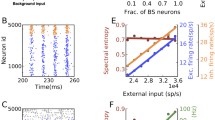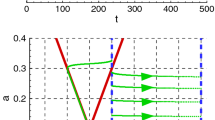Abstract
A computationally efficient, biophysically-based model of neuronal behavior is presented; it incorporates ion channel dynamics in its two fast ion channels while preserving simplicity by representing only one slow ion current. The model equations are shown to provide a wide array of physiological dynamics in terms of spiking patterns, bursting, subthreshold oscillations, and chaotic firing. Despite its simplicity, the model is capable of simulating an extensive range of spiking patterns. Several common neuronal behaviors observed in vivo are demonstrated by varying model parameters. These behaviors are classified into dynamical classes using phase diagrams whose boundaries in parameter space prove to be accurately delineated by linear stability analysis. This simple model is suitable for use in large scale simulations involving neural field theory or neuronal networks.








Similar content being viewed by others
References
Alligood, K., Sauer, T., Yorke, J. (1997). Chaos, an introduction to dynamical systems. New York: Springer.
Andrew, R.D., & Dudek, F.E. (1984). Analysis of intracellularly recorded phasic bursting by mammalian neuroendocrine cells. Journal of Neurophysiology, 51, 552–566.
Ascoli, G.A., Gasparini, S., Medinilla, V., Migliore, M. (2010). Local control of postinhibitory rebound spiking in CA1 pyramidal neuron dendrites. Journal of Neuroscience, 30, 6424–6442.
Benda, J., Longtin, A., Maler, L. (2005). Spike-frequency adaptation separates transient communication signals from background oscillations. Journal of Neuroscience, 25, 2312–2321.
Bertram, R. (1993). A computational study of the effects of serotonin on a molluscan burster neuron. Biological Cybernetics, 69, 257–267.
Bertram, R., Butte, M.J., Kiemel, T., Sherman, A. (1995). Topological and phenomenological classification of bursting oscillations. Bulletin of Mathematical Biology, 57, 413–439.
Best, J., Borisyuk, A., Rubin, J., Terman, D., Wechselberger, M. (2005). The dynamic range of bursting in a model respiratory pacemaker network. SIAM Journal on Applied Dynamical Systems. 4, 1107–1139.
Butera, R.J., Rinzel, J., Smith, J.C. (1999). Models of respiratory rhythm generation in the pre-Bötzinger complex. I. Bursting pacemaker neurons. Journal of Neurophysiology, 82, 382–397.
Canavier, C., Clark, J., Byrne, J. (1991). Simulation of the bursting activity of neuron R15 in Aplysia: role of ionic currents, calcium balance, and modulatory transmitters. Journal of Neurophysiology, 66, 2107–2124.
Chase, S.M., & Young, E.D. (2007). First-spike latency information in single neurons increases when referenced to population onset. Proceedings of the National Academy of Sciences of the United States of America, 104, 762–773.
Connor, J., Walter, D., McKown, R. (1977). Neural repetitive firing: modifications of the Hodgkin-Huxley axon suggested by experimental results from crustacean axons. Biophysical Journal, 18, 81–102.
Connors, B., & Gutnick, M. (1990). Intrinsic firing patterns of diverse neocortical neurons. Trends in Neurosciences, 13, 99–104.
Coombes, S., & Bressloff, P.C. (2005). Bursting: the genesis of rhythm in the nervous system. Singapore: World Scientific.
Desroches, M., Guckenheimer, J., Krauskopf, B., Kuehn, C., Osinga, H.M., Wechselberger, M. (2012). Mixed-mode oscillations with multiple timescales. SIAM Review, 54, 211–288.
Dickenstein, A., & Emiris, I. (2005). Solving polynomial equations: foundations, algorithms, and applications (Vol. 14). Berlin: Springer.
Dowling, J. (2001). Neurons and networks: an introduction to behavioral neuroscience. Cambridge: HUP.
Ermentrout, B. (1998a). Linearization of FI curves by adaptation. Neural Computation, 10, 1721–1729.
Ermentrout, B. (1998b). Neural networks as spatio-temporal pattern-forming systems. Reports on Progress in Physics, 61, 353.
Golomb, D., Donner, K., Shacham, L., Shlosberg, D., Amitai, Y., Hansel, D. (2007). Mechanisms of firing patterns in fast-spiking cortical interneurons. PLoS Computational Biology, 3, e156.
Gray, C., & McCormick, D. (1996). Chattering cells: superficial pyramidal neurons contributing to the generation of synchronous oscillations in the visual cortex. Science, 274, 109.
Grenier, F., Timofeev, I., Steriade, M. (1998). Leading role of thalamic over cortical neurons during postinhibitory rebound excitation. Proceedings of the National Academy of Sciences of the United States of America, 95, 929.
Guckenheimer, J., Gueron, S., Harris-Warrick, R.M. (1993). Mapping the dynamics of a bursting neuron. Philosophical Transactions of the Royal Society of London, Series A, 341, 345–359.
Guckenheimer, J., Tien, J., Willms, A. (2005). Bifurcations in the fast dynamics of neurons: implications for bursting. In Bursting: the genesis of rhythm in the nervous system (pp. 89–122). World Scientific.
Harish, O., & Golomb, D. (2010). Control of the firing patterns of vibrissa motoneurons by modulatory and phasic synaptic inputs: a modeling study. Journal of Neurophysiology, 103, 2684–2699.
Hindmarsh, J., & Rose, R. (1984). A model of neuronal bursting using three coupled first order differential equations. Philosophical Transactions of the Royal Society of London. Series B, Biological Sciences, 221, 87–102.
Hodgkin, A. (1948). The local electric changes associated with repetitive action in a non-medullated axon. Journal of Physiology, 107, 165–181.
Hodgkin, A., & Huxley, A. (1952). A quantitative description of membrane current and its application to conduction and excitation in nerve. Journal of Physiology, 117, 500.
Iglesias, C., Meunier, C., Manuel, M., Timofeeva, Y., Delestrée, N., Zytnicki, D. (2011). Mixed mode oscillations in mouse spinal motoneurons arise from a low excitability state. Journal of Neuroscience, 31, 5829–5840.
Izhikevich, E. (2007). Dynamical systems in neuroscience: the geometry of excitability and bursting. Cambridge: MIT.
Izhikevich, E., Desai, N., Walcott, E., Hoppensteadt, F. (2003). Bursts as a unit of neural information: selective communication via resonance. Trends in Neurosciences, 26, 161–167.
Krupa, M., Popovic, N., Kopell, N. (2008). Mixed-mode oscillations in three time-scale systems: a prototypical example. SIAM Journal on Applied Dynamical Systems, 7, 361–420.
Lampl, I., & Yarom, Y. (1997). Subthreshold oscillations and resonant behavior: two manifestations of the same mechanism. Neuroscience, 78, 325–341.
Lu, J., Sherman, D., Devor, M., Saper, C. (2006). A putative flip–flop switch for control of rem sleep. Nature, 441, 589–594.
McCormick, D. (2004). Membrane properties and neurotransmitter actions. In The synaptic organization of the brain. Oxford Scholarship Online Monographs (pp. 39–79).
Plant, R., & Kim, M. (1976). Mathematical description of a bursting pacemaker neuron by a modification of the Hodgkin-Huxley equations. Biophysical Journal, 16, 227–244.
Rinzel, J. (1985). Excitation dynamics: insights from simplified membrane models. Federation Proceedings, 44, 2944–2946.
Rinzel, J. (1986). A formal classification of bursting mechanisms in excitable systems. In Proceedings of the international congress of mathematicians (Vol. 1, pp. 1578–1593).
Rinzel, J., Ermentrout, G. (1998). Analysis of neural excitability and oscillations. In Methods in neuronal modeling (pp. 251–292). Cambridge: MIT.
Robinson, P., Kim, J. (2012). Spike, rate, field, and hybrid methods for treating neuronal dynamics and interactions. Journal of Neuroscience Methods, 205, 283–294.
Robinson, P., Wu, H., Kim, J. (2008). Neural rate equations for bursting dynamics derived from conductance-based equations. Journal of Theoretical Biology, 250, 663–672.
Rose, R., & Hindmarsh, J. (1989).The assembly of ionic currents in a thalamic neuron i. The three-dimensional model. Philosophical Transactions of the Royal Society of London. Series B, Biological Sciences, 237, 267–288.
Rowe, D., Robinson, P., Lazzaro, I., Powles, R., Gordon, E., Williams, L. (2005). Biophysical modeling of tonic cortical electrical activity in attention deficit hyperactivity disorder. International Journal of Neuroscience, 115, 1273–1305.
Rubin, J., & Wechselberger, M. (2008). The selection of mixed-mode oscillations in a Hodgkin-Huxley model with multiple timescales. Chaos, 18, 015105–015105.
Sherman, A. (1996). Contributions of modeling to understanding stimulus-secretion coupling in pancreatic beta-cells. American Journal of Physiology, Endocrinology and Metabolism, 271, E362–E372.
Skarda, C., Freeman, W. (1987). How brains make chaos in order to make sense of the world. Behavioral and Brain Sciences, 10, 161–195.
Steriade, M., Timofeev, I., Grenier, F. (2001). Natural waking and sleep states: a view from inside neocortical neurons. Journal of Neurophysiology, 85, 1969–1985.
Timofeev, I., & Steriade, M. (2004). Neocortical seizures: initiation, development and cessation. Neuroscience, 123, 299–336.
Timofeev, I., Grenier, F., Steriade, M. (1998). Spike-wave complexes and fast components of cortically generated seizures. IV. Paroxysmal fast runs in cortical and thalamic neurons. Journal of Neurophysiology, 80, 1439–1455.
Traub, R.D., Wong, R., Miles, R., Michelson, H. (1991). A model of a CA3 hippocampal pyramidal neuron incorporating voltage-clamp data on intrinsic conductances. Journal of Neurophysiology, 66, 635–650.
Wang, X.-J., Rinzel, J., Rogawski, M.A. (1991), A model of the T-type calcium current and the low-threshold spike in thalamic neurons. Journal of Neurophysiology, 66, 839–850.
Wilson, H. (1999a). Simplified dynamics of human and mammalian neocortical neurons. Journal of Theoretical Biology, 200, 375–388.
Wilson, H. (1999b). Spikes, decisions, and actions: the dynamical foundations of neuroscience. New York: Oxford University Press.
Xu, J., & Clancy, C.E. (2008). Ionic mechanisms of endogenous bursting in CA3 hippocampal pyramidal neurons: a model study. PloS, ONE3, e2056.
Acknowledgments
This work was supported by the Australian Research Council and the Westmead Millennium Institute.
Conflict of interest
The authors declare that they have no conflict of interest.
Author information
Authors and Affiliations
Corresponding author
Additional information
Action Editor: Bard Ermentrout
Rights and permissions
About this article
Cite this article
Zhao, X., Kim, J.W., Robinson, P.A. et al. Low dimensional model of bursting neurons. J Comput Neurosci 36, 81–95 (2014). https://doi.org/10.1007/s10827-013-0468-2
Received:
Revised:
Accepted:
Published:
Issue Date:
DOI: https://doi.org/10.1007/s10827-013-0468-2




